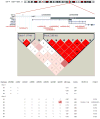Genetic association study of age-related macular degeneration in the Spanish population
- PMID: 21106043
- PMCID: PMC5745031
- DOI: 10.1111/j.1755-3768.2010.02040.x
Genetic association study of age-related macular degeneration in the Spanish population
Abstract
Purpose: To investigate new genetic risk factors and replicate reported associations with advanced age-related macular degeneration (AMD) in a prospective case-control study developed with a Spanish cohort.
Methods: Three hundred and fifty-three unrelated patients with advanced AMD (225 with atrophic AMD, 57 with neovascular AMD, and 71 with mixed AMD) and 282 age-matched controls were included. Functional and tagging SNPs in 55 candidate genes were genotyped using the SNPlex™ genotyping system. Single SNP and haplotype association analysis were performed to determine possible genetic associations; interaction effects between SNPs were also investigated.
Results: In agreement with previous reports, ARMS2 and CFH genes were strongly associated with AMD in the studied Spanish population. Moreover, both loci influenced risk independently giving support to different pathways implicated in AMD pathogenesis. No evidence for association of advanced AMD with other previous reported susceptibility genes, such as CST3, CX3CR1, FBLN5, HMCN1, PON1, SOD2, TLR4, VEGF and VLDLR, was detected. However, two additional genes appear to be candidate markers for the development of advanced AMD. A variant located at the 3' UTR of the FGF2 gene (rs6820411) was highly associated with atrophic AMD, and the functional SNP rs3112831 at ABCA4 showed a marginal association with the disease.
Conclusion: We performed a large gene association study in advanced AMD in a Spanish population. Our findings show that CFH and ARMS2 genes seem to be the principal risk loci contributing independently to AMD in our cohort. We report new significant associations that could also influence the development of advanced AMD. These findings should be confirmed in further studies with larger cohorts.
© 2010 The Authors. Acta Ophthalmologica © 2010 Acta Ophthalmologica Scandinavica Foundation.
Figures


References
-
- Abecasis GR, Yashar BM, Zhao Y, Ghiasvand NM, Zareparsi S, Branham KE, Reddick AC, Trager EH, Yoshida S, Bahling J, Filippova E, Elner S, Johnson MW, Vine AK, Sieving PA, Jacobson SG, Richards JE, Swaroop A. Age-related macular degeneration: a high-resolution genome scan for susceptibility loci in a population enriched for late-stage disease. Am J Hum Genet. 2004;74:482–94. - PMC - PubMed
-
- Allikmets R, Shroyer NF, Singh N, Seddon JM, Lewis RA, Bernstein PS, Peiffer A, Zabriskie NA, Li Y, Hutchinson A, Dean M, Lupski JR, Leppert M. Mutation of the Stargardt disease gene (ABCR) in age-related macular degeneration. Science. 1997;277:1805–7. - PubMed
-
- Baguma-Nibasheka M, Li AW, Murphy PR. The fibroblast growth factor-2 antisense gene inhibits nuclear accumulation of FGF-2 and delays cell cycle progression in C6 glioma cells. Mol Cell Endocrinol. 2007;267:127–36. - PubMed
-
- Baird PN, Chu D, Guida E, Vu HT, Guymer R. Association of the M55L and Q192R paraoxonase gene polymorphisms with age-related macular degeneration. Am J Ophthalmol. 2004;138:665–6. - PubMed

